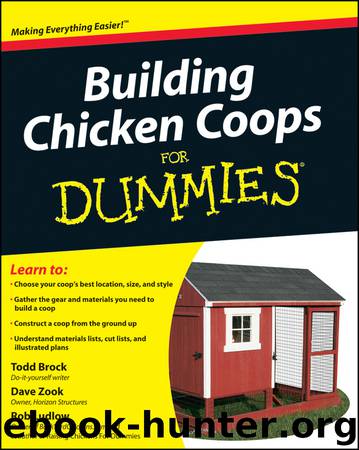Building Chicken Coops For Dummies by Todd Brock

Author:Todd Brock
Language: eng
Format: epub
Publisher: Wiley
Published: 2010-07-02T04:00:00+00:00
Walking through extra framing steps
Even though it involves some forward thinking and advance planning, it’s best to include door and window framing in the wall-framing phase of your coop project. Adding a door or window after framing can certainly be done, but you’ll find it somewhat more difficult and probably much messier.
To start framing the rough openings for a door or window, you need two key pieces of information: the door or window’s measurements, and exactly where you want it to go. You’ll then follow the same basic procedure as for a regular wall. Build on the ground, adding in a few extra steps as you go:
1. Measure, cut, and lay out the plates, studs, and king studs.
The king studs will run the entire height of the wall (minus the top and bottom plates), so cut them to the same length as the rest of the studs on that wall. Position the king studs between the top and bottom plates, and fasten them with two evenly-spaced nails or screws through the top and bottom plates.
2. Measure, cut, and lay out the header.
The header is the width of the final desired opening, plus the width of the two trimmers. For a doorway opening 30 inches wide, use a header that measures 33 inches. (After you add the trimmers at 11//2 inches wide each, you’ll be left with a 30-inch wide opening.)
• If you’re using a pre-hung door or window, use the outside measurements of the actual unit and add the width of two trimmers to arrive at your header length.
• If you’re making your own door or leaving a simple opening for a window (all covered in Chapter 8), use the measurements specified by your particular coop design.
Position the header (a 2x4 or 4x4 is usually sufficient for a coop) in between the two king studs at the proper height on the wall, remembering to measure up from the outermost edge of the bottom plate (which will eventually be at floor level).
If you decide to make your own door, know that 30, 32, and 36 inches are common door widths. You can build a narrower doorway, but think about the hundreds of times you’ll go in and out of the coop — often with a big armful of stuff — for cleaning, maintenance, or just general chicken-herding. Don’t make it harder than it needs to be by building an uncomfortably skinny door that you’ll have to sidestep through.
Headers are secured with nails or screws through the sides of the king studs. Use two evenly-spaced fasteners at each end.
3. Measure, cut, and lay out the sill.
A sill is used only in a window opening. Cut it to the same length as the window header and position it between the king studs to act as the bottom plate of the window opening. Fasten it in place with two nails or screws, driven through both king studs and into each end of the sill.
Download
This site does not store any files on its server. We only index and link to content provided by other sites. Please contact the content providers to delete copyright contents if any and email us, we'll remove relevant links or contents immediately.
Craft Beer for the Homebrewer by Michael Agnew(17953)
Marijuana Grower's Handbook by Ed Rosenthal(3525)
Barkskins by Annie Proulx(3199)
Project Animal Farm: An Accidental Journey into the Secret World of Farming and the Truth About Our Food by Sonia Faruqi(3037)
Red Famine: Stalin's War on Ukraine by Anne Applebaum(2818)
The Plant Messiah by Carlos Magdalena(2765)
0041152001443424520 .pdf by Unknown(2638)
Organic Mushroom Farming and Mycoremediation by Tradd Cotter(2575)
In the Woods by Tana French(2436)
Beer is proof God loves us by Charles W. Bamforth(2270)
7-14 Days by Noah Waters(2264)
The Art of Making Gelato by Morgan Morano(2166)
Reservoir 13 by Jon McGregor(2157)
Meathooked by Marta Zaraska(2151)
Birds, Beasts and Relatives by Gerald Durrell(2142)
Borders by unknow(2127)
The 7 Habits of Highly Effective People: Powerful Lessons in Personal Change (25th Anniversary Edition) by Covey Stephen R(2088)
Between Two Fires by Christopher Buehlman(2067)
The Lean Farm Guide to Growing Vegetables: More In-Depth Lean Techniques for Efficient Organic Production by Ben Hartman(2015)
